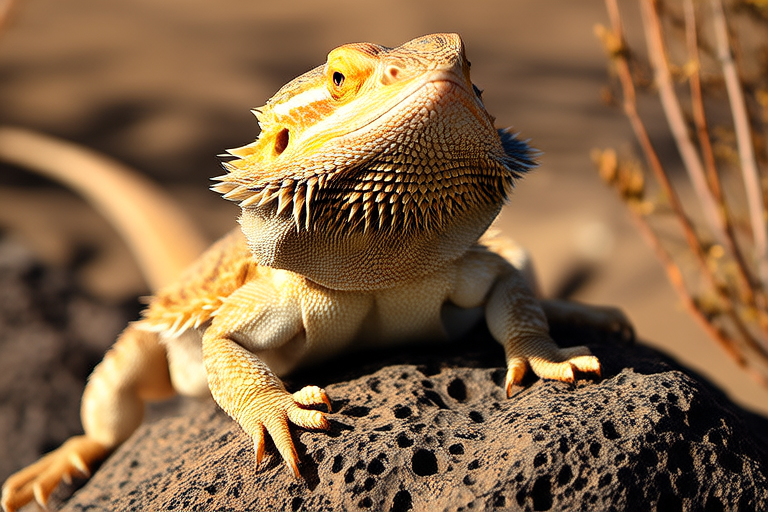Bearded Dragon Behavior Decoded: Understanding What Your Pet is Trying to Tell You
Welcome to the fascinating world of bearded dragons! These reptiles have become increasingly popular pets due to their docile nature, vibrant colors, and relatively low maintenance requirements. Native to Australia, bearded dragons are known for their unique physical features and behaviors that can often leave owners intrigued. In this article, we’ll explore the various behaviors exhibited by bearded dragons and decode what they might be trying to communicate.
The Popularity of Bearded Dragons as Pets
Bearded dragons have gained immense popularity among pet enthusiasts worldwide. Their manageable size, ranging from 16 to 24 inches, makes them ideal for apartment living. Additionally, their calm demeanor and ease of handling make them perfect for both novice and experienced reptile owners. With proper care, including appropriate diet and habitat setup, bearded dragons can live up to 10 years, providing companionship and entertainment for many years.
Common Behaviors and Their Meanings
Puffing Out the Beard
One of the most distinctive traits of bearded dragons is their ability to puff out their throat area, commonly referred to as ‘bearding.’ This behavior is often linked to stress or aggression but can also indicate excitement or interest. When a dragon puffs out its beard, it’s essentially trying to appear larger and more intimidating. This action may occur during interactions with other dragons, when introduced to new environments, or when feeling threatened. However, it’s important to note that bearding isn’t always a sign of distress; sometimes, it simply means your dragon is curious about something.
Changing Color
Bearded dragons are renowned for their ability to change color, which can range from light brown to dark green or even black. The change in color serves multiple purposes, primarily related to thermoregulation and communication. Darker hues absorb more heat, helping the dragon regulate its body temperature, while lighter colors reflect sunlight, preventing overheating. Additionally, changes in color can signal mood shifts. For instance, a stressed or ill dragon might display darker shades, whereas a happy and relaxed dragon tends to show brighter, more vibrant colors.
Body Postures
Understanding the different body postures of your bearded dragon can provide valuable insights into its emotional state. Here are some common postures and their meanings:
- Basking: When a dragon is lying flat on its belly under a heat lamp, it’s likely basking to warm up. This is a natural behavior for regulating body temperature.
- Stargazing: If you notice your dragon frequently lifting its head towards the ceiling, it’s called stargazing. While this behavior can be adorable, it may also indicate issues like respiratory infections or calcium deficiencies. Monitoring this posture closely and consulting a veterinarian if necessary is advisable.
- Glass Surfing: Some dragons exhibit glass surfing, where they repeatedly run into the glass of their enclosure. This behavior usually stems from boredom or frustration with their surroundings. Providing mental stimulation through toys, hides, and enrichment activities can help alleviate this behavior.
Interpreting Subtle Signs of Discomfort or Happiness
Bearded dragons are masters at hiding discomfort, making it crucial for owners to pay attention to subtle signs. Here are some indicators to watch for:
- Loss of Appetite: A sudden decrease in food intake can signify illness, stress, or environmental issues. Ensure the enclosure temperature and humidity levels are optimal and consult a vet if the problem persists.
- Lethargy: If your dragon appears unusually sluggish or inactive, it could be a sign of underlying health problems. Regular veterinary check-ups can help catch potential issues early.
- Excessive Shedding: While shedding is normal, excessive shedding or retained skin can indicate dehydration or improper husbandry practices. Ensuring adequate hydration and correct humidity levels is essential.
- Happiness Indicators: On the flip side, there are several signs that indicate your dragon is happy and content. These include regular basking, active movement, and responding positively to handling. Observing these behaviors can reassure you that your pet is thriving.
Building a Strong Bond Through Understanding and Respecting Behavior Cues
Establishing a strong bond with your bearded dragon involves more than just feeding and cleaning. By understanding and respecting their behavior cues, you can create a nurturing environment that fosters trust and companionship. Here are some tips:
- Patience and Consistency: Reptiles require time to acclimate to new environments and handlers. Be patient and consistent with your interactions, offering gentle handling sessions to build trust.
- Environmental Enrichment: Providing a stimulating environment with various textures, hides, and climbing structures can enhance your dragon’s well-being and encourage natural behaviors.
- Regular Health Checks: Schedule routine visits with a reptile-savvy veterinarian to ensure your pet remains healthy. Early detection of any health issues can prevent complications.
- Communication: Pay close attention to your dragon’s vocalizations and body language. Learning to recognize and respond appropriately to these cues will strengthen your bond.
In conclusion, decoding the behavior of your bearded dragon is key to understanding its needs and ensuring its well-being. From puffing out its beard to changing color and adopting various postures, each action carries significance. By interpreting these behaviors correctly and addressing any signs of discomfort promptly, you can foster a strong, trusting relationship with your scaly companion. Remember, every interaction counts, so approach your dragon with patience, respect, and love. Happy bonding!
